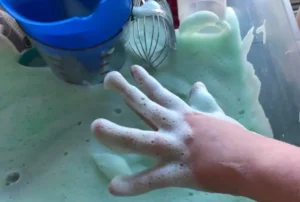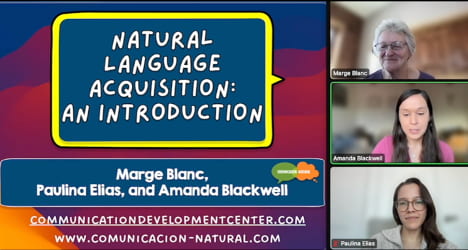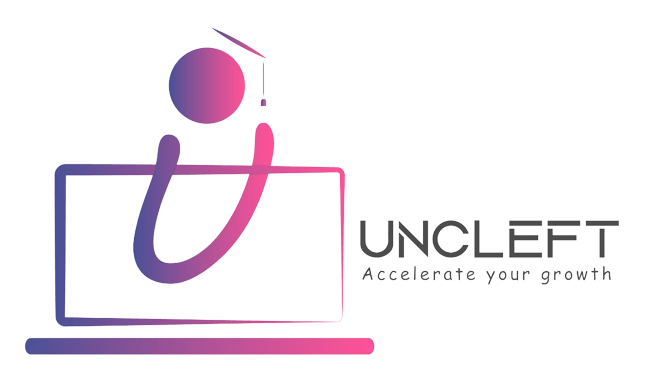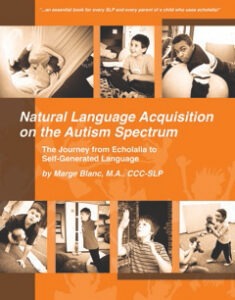Resources
As time goes on, this website will include more and more resources within the threads that are here now, and downloadable .pdfs of many of them. The NLA book itself, which started it all, is not here — because of distribution arrangements made 10 years ago which served our cause well in the early days. Even so, there are many parts of the book that have been elaborated here, and many newer stories shared by myriad parents and others.
So even if you cannot purchase the book now, you will not be far away from it. The article, “Finding the Words…to Tell the Whole Story” is not the book, but it is a very complete NLA story in itself.
The “NLA Guide” is an excellent companion to the “Finding the Words” article, as it details enough of NLA to guide you as your child undertakes their language development journey.
In addition, the resources noted on the website include links to free webinars and free courses that are popping up all over the US and the world.
Although the videos here are not full length courses, when they are all here, they will add up to full courses — and more. Enjoy your journey — and stay tuned!
Background of NLA
Marge was asked to record a short video of the background of NLA, and how her clinical research provides a detailed description of gestalt language development. An SLT in Ireland was preparing a course for professionals in Ireland and the UK, and wanted her to explain how the original research of Barry Prizant et al, and Ann Peters et al provides the evidence of gestalts as single units of meaning, and how gestalts are used by gestalt language processors in natural language development. Marge describes how the research is both long-standing and up-to-date.
Assessment.at.home
Nellie shares how the first assessment of her new practice was conducted: at home! After consultation with her new client’s parents, she made some careful plans, some of which worked! Overall, the assessment was a great success, and Nellie explains why!

N of 1
M. Blanc: Thank you N of 1, Jennifer Cronk! You also are an N of 1, as you bravely forged ahead without a body of evidence to guide you! Kate Shapiro Flaxman paid tribute to you yesterday when she was quoted on the podcast, Talking with Tech, that adding favorite
Gestalt Language Processing in your Classroom
Here’s the handout you asked us for! Formulated by the NLA Classroom Committee made up of SLPs and teachers, this two-page handout uses little post-it notes to highlight simple strategies that are a life-line for your GLPs, but benefit all your students with their common-sense approach to child development and communication.
Developmental Sentence Types (DST)
This is the well-organized answer to the question “How do I support my child’s emergence from Stage 3 to Stage 4?” Research-based and compiled by Laura Lee and Susan Canter (1971), Developmental Sentence Types (DST) helps you know which two and three-word combos to use when your GLP is just beginning to move into ‘pre-sentence grammar.’ Look at the Stage 4 discussion for the principles of how to use it to your child’s advantage.
Developmental Sentence Scoring (DSS)
Here’s the companion handout that helps you further support GLPs as they move from the phrases of DST to the other phrases and sentences of Stage 4 (and Stage 5, and Stage 6). Also by research-based, DSS shows how grammar naturally develops in all children, analytic or gestalt, once they emerge from the wealth of 2 and 3-word phrases of DST. Normed on ALPs, DSS norms should not be reported for GLPs, but the progression is the same for both groups of kids. NLA Stage 4 = DSS 1-3. NLA Stage 5 = DSS 4-6. NLA Stage 6 = DSS 7-8.
NLA Assessment Form
Here is a form you can use to transcribe language samples, and to score them.
NLA book, Chapter 19
This is the revised version of Chapter 19 of the NLA book. It includes Scoring Guidelines that are slightly revised from the original version in the book.
This is a FREE one-hour, pre-recorded introductory presentation that describes the overall concept of gestalt language processing (GLP), provides some of the history of the scientific evidence, and provides a brief overview of the stages of Natural Language Acquisition (NLA).
It’s here!
Marge Blanc is presenting a 2-week Gestalt Language Processing Certification course through Uncleft.com!
Live sessions on Saturday, October 19 and Saturday, October 26! Self-paced learning during the week.
You will come away with a deep understanding of gestalt language development through a neurodiversity lens.
Marge is known as one of the leading researchers in language development and treatment, and the author of Natural Language Acquisition on the Autism Spectrum: The Journey from Echolalia to Self-Generated Language.
Here’s what others say about Marge:
“I am grateful to be part of a community led by Marge Blanc, whose passion for research and dedication to accessibility truly stand out.”
Marge … “inspires us all with her unwavering commitment to our mission. Marge fosters a collaborative environment where ideas are shared freely, making it easy for everyone to contribute and grow. Marge’s ability to connect with individuals and champion inclusivity not only enhances our work but also strengthens our community. It’s a privilege to learn from someone so dedicated to creating such a positive impact on the ‘naturalness’ of language development.
Marge is … “unwavering in her dedication to Natural Language Acquisition and the individuals that it places at its center – those who for so many years were ignored while the intentions of their communication went unheard. She is a pioneer in our field and I am honored to know her and to have learned from her.”


